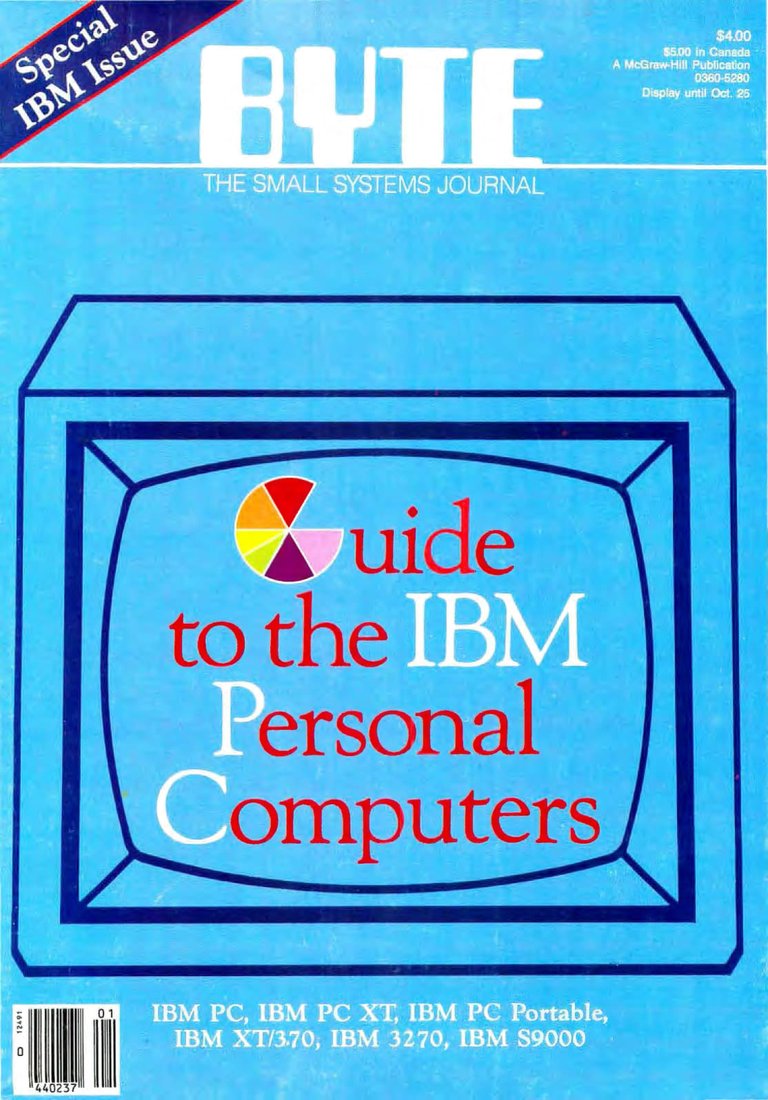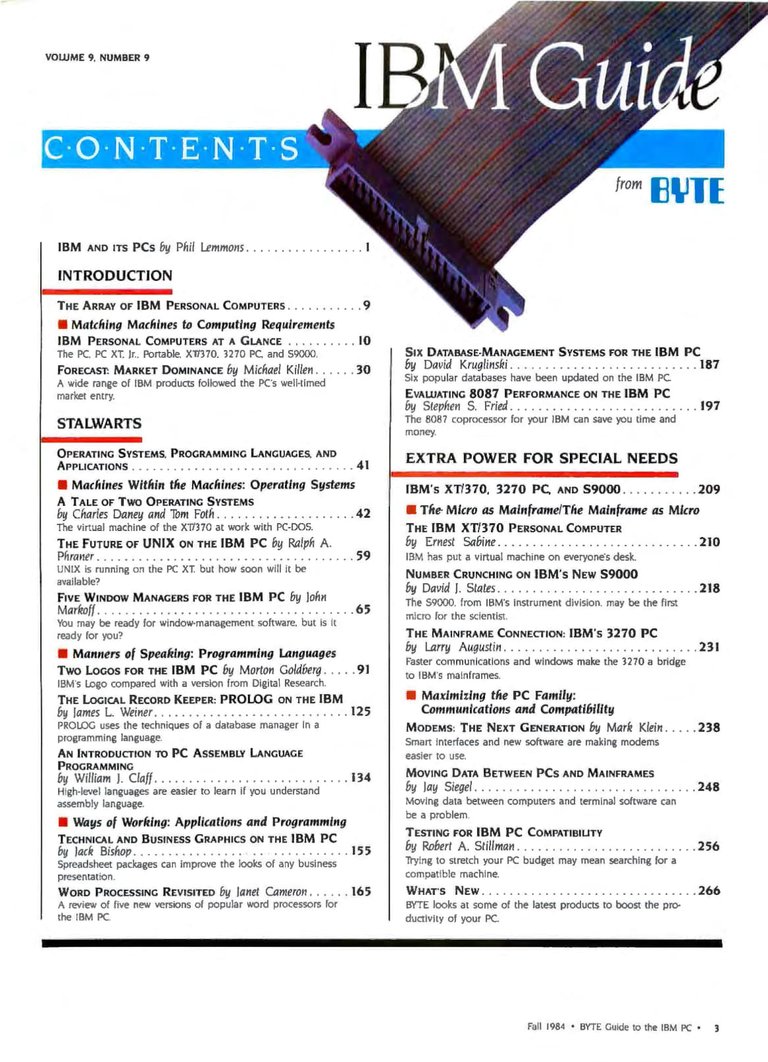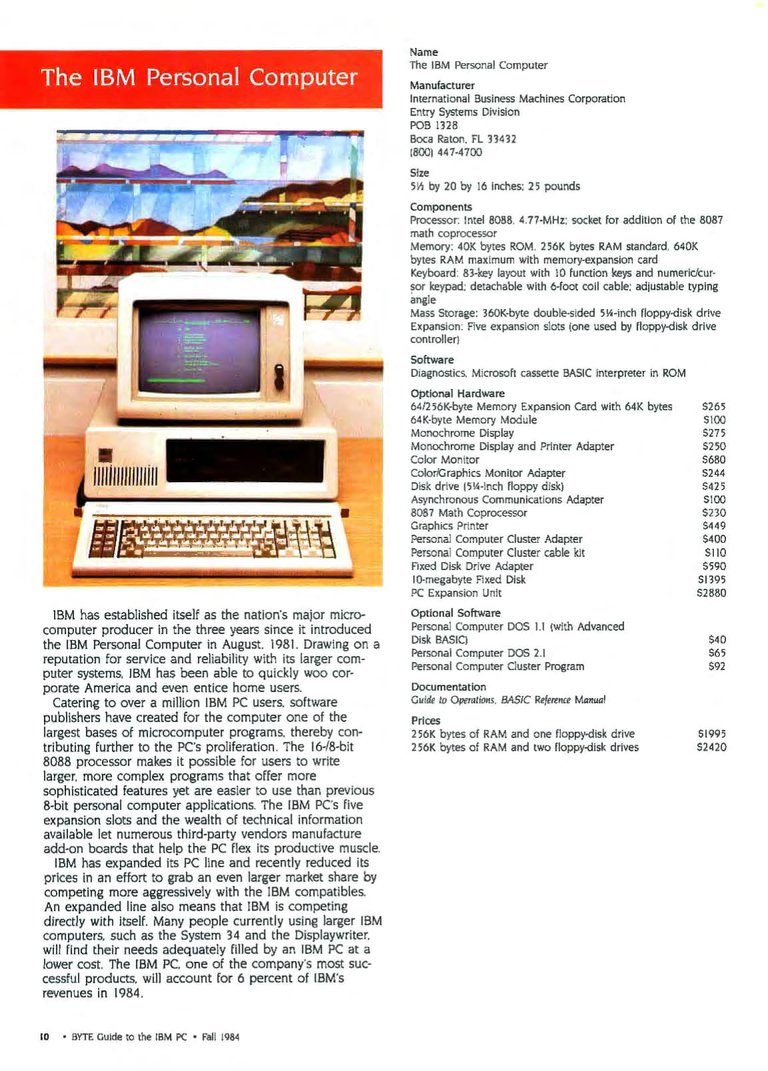
Cover of the September 1984 issue of BYTE
This issue of Byte was a special issue emphasizing IBM. The IBM PC had been released a few years earlier and even in 1984, it wasn't a given that the PC and DOS were going to take over the world. CP/M was still around with CP/M 86 having been introduced as well and even "compatible" PCs were not always that compatible yet. I think Byte did one of these IBM special issues (which also covered IBM's larger systems as well) for a few years at least. The September 1984 issue of Byte includes:
Introduction
- IBM and its PCs - How IBM stepped into a void in a crowded market to provide the ability to address a lot of memory (for the time), an 80 column display, an open system architectures, and a good keyboard/word processing combo...a combination of features lacking in other systems. I find it interesting that this editorial calls the IBM PC the third major standard behind CP/M and the Apple II. Not sure how the Apple II gets that label as there were other machines nearly or in some cases more popular. The Apple II line (including the IIgs) sold 5-6 million machines, the TRS-80 line sold 2.5 million, Atari sold 4-5 million Atari 8-bit computers and the Commodore 64 sold 17-20 million Commodore 64s and I don't think that number includes the compatible Commodore 128 that sold around 4 million. Granted, all of these systems were still in production when this issue was published so these numbers had not yet been reached.
- IBM Personal Computers at a Glance - While there were a number of upgrades available, a basic IBM PC in 1984 included an Intel 8088 4.77MHz CPU, 256K RAM (max 640K), 360K 5.25-inch floppy drive, and five expansion slots for $1995. The IBM PC XT was very similar but included a 10 MB hard drive and eight expansion slots and cost $4395. The PCjr was IBMs attempt at a purely "home computer" and included only 64K (max 128K) and a terrible chicklet keyboard but included a built-in color adapter and cartridge slots (but no standard expansion slots). Finally, there was the IBM Portable PC which basically had the same specs as the IBM PC in a luggable form factor and built-in 9-inch amber monitor. Then there were specialized configurations designed for use with IBMs mainframes and other specialized machines.
- Forecast: Market Dominance - IBM shipped 600,000 IBM PCs and XTs in 1983 and all signs were pointing to dominance by IBM in the personal computer market. It would take almost another decade before the IBM PC standard was essentially the only standard. Ironically, in another 10 years IBM would be exiting the personal computer business.

Table of Contents from the September 1984 issue of BYTE
Stalwarts
- A Tale of Two Operating Systems - A comparison of Microsoft's PC-DOS (which was at version 2.0 at this point) and IBM's XT/370 OS.
- The Future of UNIX on the IBM PC - A look at UNIX on the IBM PC (which was already available at the time).
- Five Window Managers for the IBM PC - Before Microsoft Windows came to dominate, there were numerous other window managers that ran on top of DOS. This article includes a preview of five of them including DesQ, WindowMaster, VisiOn, Concurrent DOS, and of course Windows itself.
- Two Logos for the IBM PC - A comparison of two implementations of Logo including one by Digital Research (DR Logo) and one by IBM (IBM Personal Computer Logo).
- The Logical Record Keeper: PROLOG on the IBM PC - A look at a PROLOG implementation for the IBM PC based on DEC-10 PROLOG.
- An Introduction to PC Assembly Language - A beginner's guide to assembly language on the 8088. The only assembly language programming I ever did was on a 68000 in college. I understand that the 68000 is much nicer to program for in assembly than 8086/8088 CPUs and their derivatives.
- Technical and Business Graphics on the IBM PC - Business graphics meant things like charts, graphs and presentation software. While most things are PowerPoint today, such "business graphics" were done with a combination of spreadsheet software, graphing software, and presentation software. Some of the software looked at here includes SuperCalc3, Lotus 1-2-3, GrafTalk, Business Graphics System, DR Graph and ChartMaster.
- Word Processing Revisited - Reviews of the latest versions of WordStar, Word, pfs:Write, MultiMate, and FinalWord.
- Six Database-Management Systems for the IBM PC - A comparison of six popular DBMSs for the PC including Condor 3 2.11, dBASE II 2.4A, R:base 4000 1.10, KnowledgeMan 1.06, C.I.P 1A, and pfs:file/pfs:report.
- Evaluating 8087 Performance on the IBM PC - The 8087 is the optional math co-processor that works with the IBM PC and IBM PC XT (as well as some clones). This article evaluates its performance and even compares some functions on a Cray super computer (which was "only" 180 times faster in some cases).

The IBM PC
Extra Power for Special Needs
- The IBM XT/370 Personal Computer - The XT/370 was a special version of the IBM PC XT that could operate as an XT personal computer, an interactive full screen terminal to a mainframe, or in a mode that can actually run System/370 programs.
- Number Crunching on IBM's New S9000 - The S9000 was based on the Motorola 68000 CPU and could use large amounts of RAM (2 MB or more). It was designed for scientific uses and this article evaluates its performance for use in nuclear magnetic resonance spectrometry.
- The Mainframe Connection: IBM's 3270 PC - The 3270 PC was a special version of the PC that included the high speed terminal interface for mainframes and could simultaneously run DOS programs.
- Modems: The Next Generation - A comparison of some of the latest modems including the Prentice X100 POPCOM ($475), Hayes Smartmodem 1200B ($599), Bizcomp PC-Intellimodem ($499), Novation ACCESS 1-2-3 ($595), Cermetek INFO-MATE 212PC ($480), and Microcom ERA2 ($499). All support 1200bps.
- Moving Data Between PCs and Mainframes - Today, moving data around is trivial. In the olden days, moving data between mainframes and personal computers could be more of a pain.
- Testing for IBM PC Compatibility - There were many PC "compatible" machines by 1984. However, in the early days, compatibility could vary. Some machines were more compatible than others. This article presents two programs that can test for compatibility issues.
- What's New - CallText 5000 text-to-speech converter and telephone interface, Micro-Design hard drives (5 to 22 MB), RAM+6 multifunction card with real-time clock, Multi-Tech MultiModem, AST MPII 64K memory expansion and clock/calendar, Spellbinder, PortaAPL, Metafile 8.0, and much more.

Back cover of the September 1984 issue of BYTE
...and more!
Check out some of my other recent posts:
Vintage Photos - Lot 3 (329-332)
https://ecency.com/photography/@darth-azrael/vintage-photos-lot-3-329
MacAddict (August 1997)
https://ecency.com/retrocomputing/@darth-azrael/macaddict-august-1997
Vintage Photos - Lot 3 (325-328)
https://ecency.com/photography/@darth-azrael/vintage-photos-lot-3-325
Brevard Renaissance Fair 2020: The Craic Show (17) - In Taberna
https://ecency.com/music/@darth-azrael/mmdamobfka
Vintage Photos - Lot 3 (321-324)
https://ecency.com/photography/@darth-azrael/vintage-photos-lot-3-321
Digital Archaeology: Gateway NV57H
https://ecency.com/retrocomputing/@darth-azrael/digital-archaeology-gateway-nv57h
Check out my other Social Media haunts (though most content is links to stuff I posted on Hive or reposts of stuff originally posted on Hive):
Wordpress: https://www.megalextoria.com/wordpress
Tumblr: https://www.tumblr.com/blog/darth-azrael
X: https://x.com/Darth_Azrael
Blogger: https://megalextoria.blogspot.com/
Odyssee: https://odysee.com/@Megalextoria:b
Rumble: https://rumble.com/c/c-2385054
Daily Motion: https://www.dailymotion.com/Megalextoria
Books I am reading or have recently read:
A Declaration of the Rights of Magicians by H.G. Parry
The Way of Kings by Brandon Sanderson
The British Are Coming: The War for America, Lexington to Princeton, 1775-1777 by Rick Atkinson
Mine Monero in your browser!
Earn Gridcoin while also helping various scientific projects by sharing your computer's idle CPU time!
